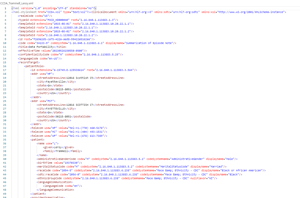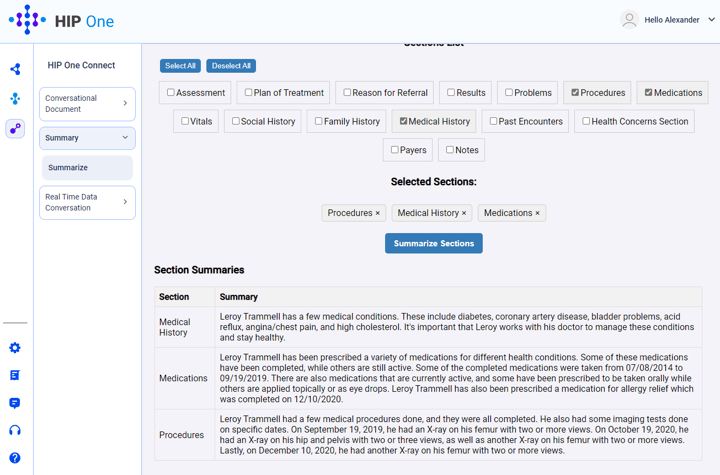In the fast-paced world of healthcare, effective communication and seamless information exchange are vital for providing quality patient care. Continuity of Care Documents (CCDs) have emerged as a standardized format for sharing patient health information across different systems and organizations. However, CCDs face challenges related to usability and user experience.
In this blog post, we will explore the hurdles and how Genzeon CCD Summarization is helping the healthcare industry by addressing these challenges.
Industry-wide CCDs Challenges
- Interoperability: The interoperability challenge arises from the use of different standards and formats for CCDs across various healthcare systems. This can lead to data loss, errors, and difficulties in exchanging information smoothly.
- Data Quality and Consistency: Incomplete or inaccurate data within CCDs can hinder effective care coordination. Gaps in medical history, medication lists, or allergies may compromise patient safety and the quality of care.
- Lack of Standardization and Governance: Customization and variations in CCD templates among different electronic health record (EHR) vendors and healthcare organizations make it challenging to achieve standardization. This can impede the seamless exchange and interpretation of CCDs.
 Usability and User Experience: CCDs can be complex and overwhelming to navigate. The lack of user-friendly interfaces and intuitive designs makes it difficult for healthcare providers to extract relevant information efficiently.
Usability and User Experience: CCDs can be complex and overwhelming to navigate. The lack of user-friendly interfaces and intuitive designs makes it difficult for healthcare providers to extract relevant information efficiently.
Overcoming CCDs Usability and User Experience Challenges
Genzeon has been working on different challenges with CCDs. One of the challenges Genzeon has taken up is to enhance the usability and user experience of CCDs through their CCD Summarization solution. By leveraging the power of advanced technologies, such as large language models (LLMs), Genzeon has transformed the way healthcare providers view and interact with CCDs. They understand that the summary needs for different scenarios, such as an emergency room visit, an office visit, or working with a life insurance company, may vary.
Genzeon's CCD Summarization solution, a feature in the HIP Connect module of HIP One, provides a flexible approach to cater to diverse requirements, enabling healthcare providers to effectively manage CCDs in various contexts. The solution allows customization for viewing different sections of CCDs, presenting the information in a user-friendly language that reduces the time required to comprehend complex CCDs and locate the necessary information. Additionally, CCD Summarization offers a timeline view of different sections, facilitating quick access to section-specific data with just a single click. This adaptability empowers healthcare providers to efficiently retrieve the required information, irrespective of the specific demands of the situation.
Figure 2: Screenshot of CCD Summarization within HIP Connect
Key Benefits of CCD Summarization
- Enhanced User Experience: The CCD Summarization solution by Genzeon offers a user-friendly interface that simplifies the reading and interpretation of CCDs. It provides a more intuitive and visually appealing experience for healthcare providers, facilitating faster access to critical patient information.
- Precise and Concise Summaries: Genzeon's CCD Summarization algorithm generates concise summaries of CCDs, highlighting the most essential information. This saves healthcare providers valuable time by providing a quick overview of the patient's medical history, diagnoses, medications, and other essential data.
- Improved Care Coordination: With CCD Summarization, healthcare providers can quickly grasp the key details of a patient's health status. This facilitates better care coordination among different providers.
- Greater Efficiency and Patient Care: By streamlining the process of reviewing CCDs, Genzeon's solution enables healthcare providers to work more efficiently. With easy access to summarized CCD information, they can spend less time navigating complex documents and focus more on providing personalized and high-quality care to patients.
Conclusion
Continuity of Care Documents (CCDs) play a vital role in facilitating the exchange of patient information in healthcare. However, challenges such as interoperability, data quality, lack of standardization, and usability hinder their effectiveness.
Genzeon's CCD Summarization solution addresses these challenges by offering an enhanced user experience, concise summaries, and improved care coordination. By leveraging advanced technologies, Genzeon is revolutionizing the way healthcare providers interact with CCDs, leading to greater efficiency, better patient care, and improved health outcomes.




